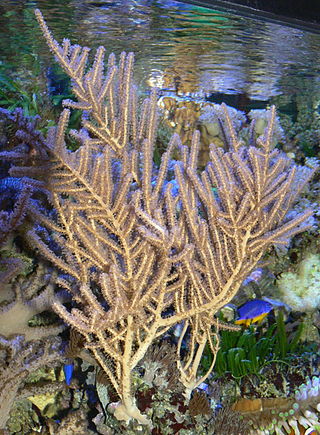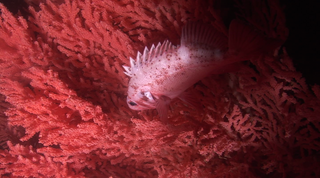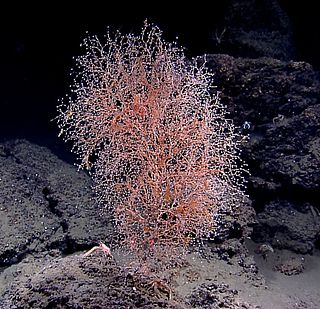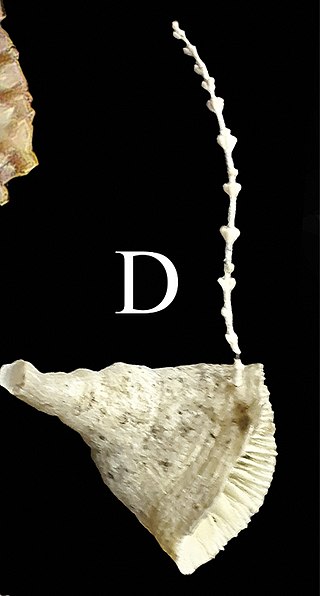
Anthozoa is a class of marine invertebrates which includes the sea anemones, stony corals and soft corals. Adult anthozoans are almost all attached to the seabed, while their larvae can disperse as part of the plankton. The basic unit of the adult is the polyp; this consists of a cylindrical column topped by a disc with a central mouth surrounded by tentacles. Sea anemones are mostly solitary, but the majority of corals are colonial, being formed by the budding of new polyps from an original, founding individual. Colonies are strengthened by calcium carbonate and other materials and take various massive, plate-like, bushy or leafy forms.

Zoanthids are an order of cnidarians commonly found in coral reefs, the deep sea and many other marine environments around the world. These animals come in a variety of different colonizing formations and in numerous different colors. They can be found as individual polyps, attached by a fleshy stolon or a mat that can be created from small pieces of sediment, sand and rock. The term "zoanthid" refers to all animals within this order Zoantharia, and should not be confused with "Zoanthus", which is one genus within Zoantharia.

Alcyonacea are an order of sessile colonial cnidarians that are found throughout the oceans of the world, especially in the deep sea, polar waters, tropics and subtropics. Whilst not in a strict taxonomic sense, Alcyonacea are commonly known as soft corals. The term "soft coral" generally applies to organisms in the two orders Pennatulacea and Alcyonacea with their polyps embedded within a fleshy mass of coenenchymal tissue. Consequently, the term "gorgonian coral" is commonly handed to multiple species in the order Alcyonacea that produce a mineralized skeletal axis composed of calcite and the proteinaceous material gorgonin only and corresponds to only one of several families within the formally accepted taxon Gorgoniidae (Scleractinia). These can be found in order Malacalcyonacea (taxonomic synonyms of include : Alcyoniina, Holaxonia, Protoalcyonaria, Scleraxonia, and Stolonifera. They are sessile colonial cnidarians that are found throughout the oceans of the world, especially in the deep sea, polar waters, tropics and subtropics. Common names for subsets of this order are sea fans and sea whips; others are similar to the sea pens of related order Pennatulacea. Individual tiny polyps form colonies that are normally erect, flattened, branching, and reminiscent of a fan. Others may be whiplike, bushy, or even encrusting. A colony can be several feet high and across, but only a few inches thick. They may be brightly coloured, often purple, red, or yellow. Photosynthetic gorgonians can be successfully kept in captive aquaria.

Hexacorallia is a class of Anthozoa comprising approximately 4,300 species of aquatic organisms formed of polyps, generally with 6-fold symmetry. It includes all of the stony corals, most of which are colonial and reef-forming, as well as all sea anemones, and zoanthids, arranged within five extant orders. The hexacorallia are distinguished from another class of Anthozoa, Octocorallia, in having six or fewer axes of symmetry in their body structure; the tentacles are simple and unbranched and normally number more than eight. These organisms are formed of individual soft polyps which in some species live in colonies and can secrete a calcite skeleton. As with all Cnidarians, these organisms have a complex life cycle including a motile planktonic phase and a later characteristic sessile phase. Hexacorallia also include the significant extinct order of rugose corals.

Octocorallia is a class of Anthozoa comprising over 3,000 species of marine organisms formed of colonial polyps with 8-fold symmetry. It includes the blue coral, soft corals, sea pens, and gorgonians within three orders: Alcyonacea, Helioporacea, and Pennatulacea. These organisms have an internal skeleton secreted by mesoglea and polyps with eight tentacles and eight mesentaries. As with all Cnidarians these organisms have a complex life cycle including a motile phase when they are considered plankton and later characteristic sessile phase.

Acanella is a genus of deep sea bamboo coral of the family Isididae. Acanella are mainly studied and found in Hawaii, they are able to survive in high-flow sites and are preyed upon by nudibranch mollusks. It has a high fecundity and small size that allows high dispersal and recruitment; however, it has been classified as a vulnerable marine organism due to its vulnerability to bottom fishing gear. It contains the following species:

Coralliidae, also known as precious corals, is a taxonomic family of soft corals belonging to the suborder Scleraxonia of the phylum Cnidaria. These sessile corals are one of the most dominant members of hard-bottomed benthic environments such as seamounts, canyons and continental shelves. From this coral family results 69 descendants in which each species plays a key role in forming habitats for a variety of marine species.

Holaxonia is a suborder of soft corals, a member of the phylum Cnidaria. Members of this suborder are sometimes known as gorgonians and include the sea blades, the sea fans, the sea rods and the sea whips. These soft corals are colonial, sessile organisms and are generally tree-like in structure. They do not have a hard skeleton composed of calcium carbonate but have a firm but pliable, central axial skeleton composed of a fibrous protein called gorgonin embedded in a tissue matrix, the coenenchyme. In some genera this is permeated with a calcareous substance in the form of fused spicules. Members of this suborder are characterized by having an unspiculated axis and often a soft, chambered central core. The polyps have eight-fold symmetry and in many species, especially in the families Gorgoniidae and Plexauridae, contain symbiotic photosynthetic algae called zooxanthellae. These soft corals are popular in salt water aquaria.

Primnoa(Lamororux, 1812) also known as red tree coral, is a genus of soft corals and the type genus of the family Primnoidae (Milne Edwards, 1857). They are sessile, benthic cnidarians that can be found in the North Pacific, North Atlantic, and Subantarctic South Pacific, and its members often play a vital ecological role as keystone species within their environment as a habitat and refuge for the megafauna that also inhabit those regions. This, in combination with their slow growth, makes the increasing disturbance to their habitats caused by fishing activities particularly impactful and difficult to recover from.

Primnoidae is a family of soft corals.

Primnoa pacifica or red tree coral is a species of soft coral in the family Primnoidae. It is a deep water coral found in the North Pacific Ocean, and plays an integral role in supporting benthic ecosystems. Red tree corals grow axially and radially, producing structures of calcite and gorgonian skeletons that form dense thickets. Like other species of coral, red tree coral is made of a soluble form of calcium carbonate, which forms the reef structure, as well as provides food, shelter, and nutrients for surrounding organisms. Amongst the organisms red tree corals provide a home for, many are commercially important fish and crustaceans. These areas of marine habitat are listed as Habitat Areas of Particular Concern. However, anthropogenic impacts such as bottom trawling pose large-scale threats to these habitats. There are also concerns about the effects of ocean acidification on red tree coral, since it shares many of the same properties as other corals that are suffering from bleaching.

Plexauridae is a family of marine colonial octocorals in the phylum Cnidaria. Members of this family are found in shallow tropical and subtropical seas. Many species contain symbiotic photosynthetic protists called zooxanthellae.

Savalia savaglia, commonly known as gold coral, is a species of colonial false black coral in the family Parazoanthidae. It is native to the northeastern Atlantic Ocean and the Mediterranean Sea where it often grows in association with a gorgonian. It is extremely long-lived, with a lifespan of 2,700 years, and develops into a large tree-like colony.

Chrysogorgia is a genus of soft corals in the family Chrysogorgiidae.
Callogorgia elegans is a species of soft corals in the family Primnoidae. It is found in the north-western Pacific Ocean. Like other coral species, C. elegans is bottom-dwelling and sessile, or immobile.
Swiftia comauensis species of gorgonian-type octocoral in the family Plexauridae, only found in the Comau fiords of Huinay in the Hualaihué province of the region of Los Lagos, Chile.

Narella is a genus of deep-sea soft corals in the family Primnoidae (Milne Edwards, 1857). They are sessile, bottom-dwelling organisms that can be found in all ocean basins, having cosmopolitan distribution. They have a branching appearance.
Paracalyptrophora is a genus of corals belonging to the family Primnoidae.

Convexella is a genus of corals belonging to the family Primnoidae, first described by Frederick Bayer in 1996.














